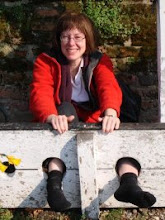I recently received an email from Wendy in Michigan - she had not found anything about designing or marking wholecloth quilts and wondered if I could point her in the right direction with some books. I am sharing my reply with you, in case it might be of use.....
Dear Wendy,
Yes, wholecloths are a bit specialised!!
For Welsh quilts you could try Making Welsh Quilts by Mary Jenkins and Clare Claridge. Also the book by Marjorie Horton on Welsh Quilting Pattern & Design Handbook (self published??) more on designing tho than the actual how to mark and make up.
For Durham and Welsh full size templates and patterns - try the following:
Diana Lodge - Quilting - Traditional Needle Arts- Mitchell Beazley has both Welsh and Durham quilts also Sanderson Star pattern.
Also try Essential Quilting Project Book by Barbara Chainey - also has full size templates including Sanderson Star, Welsh and Durham strippy quilts.
There is also Amy Emms' Story of Durham Quilting - instructions a bit sparse but OK if you know what you're doing....
Also Dorothy Osler's British Quilts has instructions for a strippy.
The old method would have involved sitting down at the frame and using templates on the cloth - marking around them with chalk or needle marking and filling in the rest freehand; the modern method would involve making a paper pattern (either with hand drafted patterns or using the computer) and then tracing this onto the fabric with a light table. In the course that I took on wholecloth quilts, we used the paper method where you draw/design a quarter pattern of the centre medallion, then a quarter of an outer border - use these to mark the whole quilt top and finally adding the infill diamond hatching (using a separate sheet of diamonds to mark where necessary).
There are several books on the hand quilting stitch but apart from looking at old quilts it would be hard to describe designing a wholecloth.
The above books are mostly out of print but you can get them at the library or from Amazon or Abe books or other online sellers that sell used books.
Hope that helps
Pippa
Subscribe to:
Post Comments (Atom)

Great resources! That Chainey book is the one responsible for getting me into Welsh quilting in the first place, as there is an absolutely luscious red wholecloth in there. I wasn't aware of the Horton, but it looks like I will have to buy it now. Here are a few more I've found to be useful.
ReplyDelete1. Going through your website and saving all the images of Welsh quilts into a folder to use for reference.
2. June Tailor's "Mix and Match" templates are sets of certain shapes, 6 different sizes per set. You can have circles, hearts, paisleys (sold as feathers), leaves, twisted leaves, flowers, ovals.
3. The Stencil Company in America has a fantastic range of stencils which can be used for Welsh quilting, particularly borders and infill patterns.
4. Creative Grids sells a ruler for making circles in various sizes which I find incredibly useful for drafting quilting patterns.
I've done Welsh quilting on a patchwork quilt, and I'm soon to embark on my first wholecloth. The plan is to draw the design on to a few pieces of A1 taped together (I get flipchart paper), pin the fabric on top, and trace it on using a Crayola washable marker pen.
Thanks for that, Ellettaria - the Crayola pens are great but do test first on a sample of cloth as not all the colours wash out equally. Also did you know about the washable felt tips that are available in WH Smiths? These have finer nibs than the Crayola ones (which are a bit thick). I made a good light table with a sheet of perspex (plexiglass) and four wrapped bricks and together with a fluorescent light this has served me well. Pin the fabric securely on the cloth before you trace and be sure to find your centre lines and diagonals first - some people do sew guide threads first to facilitate the tracing process. Pippa
ReplyDeleteWonderful suggestions, thanks for the info.
ReplyDeleteThanks for the Infos. I quite like traditional quilts and maybe one day when I think I'm good enough I will try one. I quite like how the whole cloths show off the quilting itself, and the quilting is not used to highlight the fabric.
ReplyDeleteI agree with you completely, Pippa: it is very hard to describe how to design a wholecloth. I have been asked many times to offer a workshop about that topic and until today I haven't found a reasonable concept for it. The best way to learn is looking at quilts, let yourself be inspired by them and study how they are designed! And then find your own way of doing it.
ReplyDelete